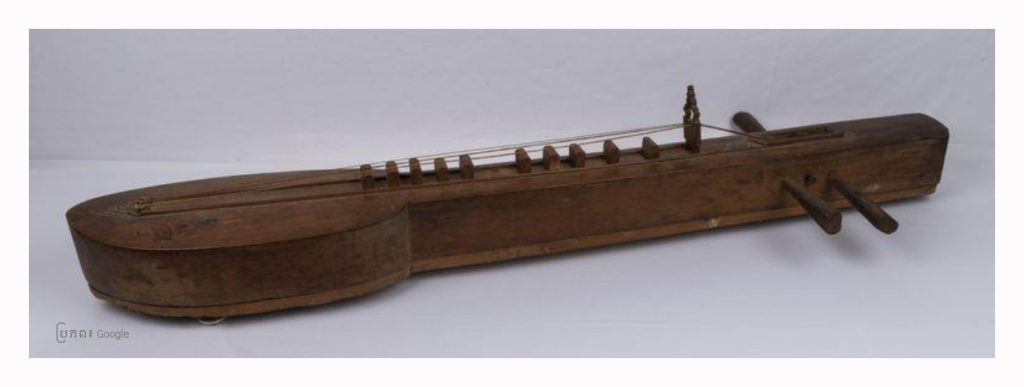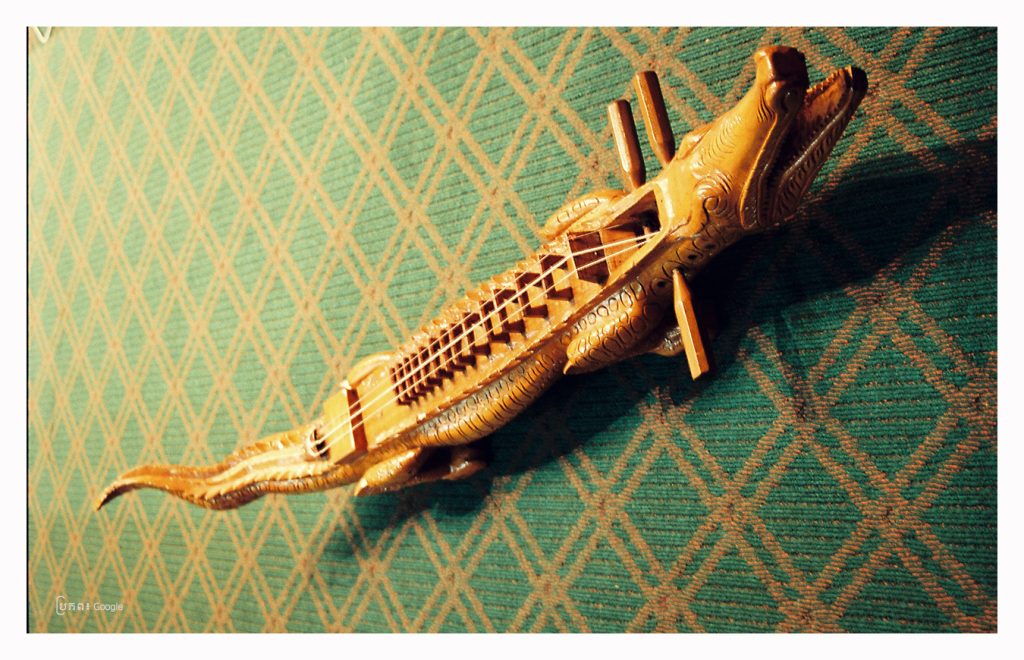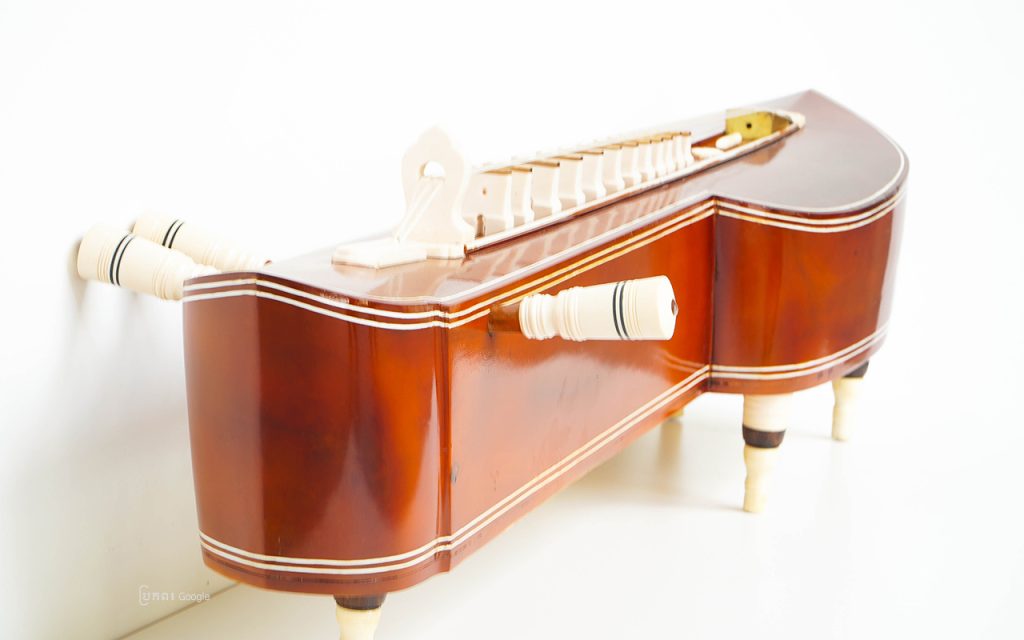ខ្មែរយើងប្រើឈ្មោះផ្សេងៗគ្នា សំដៅទៅលើឧបករណ៍តន្ត្រីខ្មែរ «ក្រពើ»។ គេឃើញមានប្រភេទឧបករណ៍តន្ត្រី ក្រពើ នេះនៅក្នុងតំបន់អាស៊ី ដូចជាប្រទេសហ្វ៊ីលីព្ពីន ម៉ាឡេស៊ី ឥណ្ឌូណេស៊ី មីយ៉ានម៉ា ថៃឡង់ដ៍ ឡាវ និងកម្ពុជា។ នៅក្នុងបណ្តាប្រទេសទាំងនេះ គេប្រើឈ្មោះនៅក្នុងចំណាត់ថ្នាក់តន្ត្រី(Organology) ថា «លូត» ឬ «ហ្ស៊ីឌើ» (lute or zither: boat lute, boat zither, board zither, box zither, or floor zither)។
នៅក្នុងចំណាត់ថ្នាក់តន្ត្រី «លូត» (lute) ជាប្រភេទឧបករណ៍ន្ត្រី «ចាប៉ី» ដែលគេច្រើនព្យួរនឹងក ហើយដេញឬកេះ។ ឯ «ហ្ស៊ីឌើ» (zither) គេដាក់នៅលើផ្ទៃរាបស្មើមួយ ដែលអ្នកលេងអង្គុយនៅពីក្រោយឧបករណ៍ហើយដេញឬកេះដែរ។ ចំណែកឯពាក្យដែលគេភ្ជាប់ជាមួយពាក្យ «លូត ឬ ហ្ស៊ីឌើ» មួយម៉ាត់ទៀតគឺ «ទូក (boat), ប្រអប់ (board/box), និងក្តារឬផ្ទៃក្រាល(floor)» គឺសំដៅទៅលើរូបរាងឬសណ្ឋានឧបករណ៍ដែលមានរាងឬសណ្ឋានដូចទូកឬប្រអប់ និងដាក់នៅលើក្តារឬផ្ទៃក្រាលដើម្បីនឹងសម្តែង។ តាមការពិត លូតនិងហ្ស៊ីឌើ ទោះបីវាជាគ្រឿងខ្សែនិងដេញឬកេះដូចគ្នាមែនពិត តែវាជាប្រភេទឧបករណ៍តន្ត្រីពីរផ្សេងគ្នា។ ឯកសារមួយចំនួនបានអះអាងថា ប្រភេទឧបករណ៍តន្ត្រីហ្ស៊ីឌើ មានការអភិវឌ្ឍនិងក្លាយមកពីប្រភេទឧបករណ៍តន្ត្រីលូត។ មានន័យថា ឧបករណ៍ក្រពើ មានការអភិវឌ្ឍនិងក្លាយមកពីឧបករណ៍ចាប៉ី។ លោក ប៉ាទ្រិក កែរសាឡេ (Patrick Kersalé) យល់ថាអំណះអំណាងនេះមិនត្រឹមត្រូវទេ ទោះបីប្រភេទឧបករណ៍លូតនិងហ្ស៊ីឌើស្ថិតនៅក្នុងចំណាត់ថ្នាក់តន្ត្រីជាគ្រឿងខ្សែដូចគ្នាក៏ដោយ។ លើសពីនេះទៅទៀត លោកក៏បានផ្តល់ជាព័ត៌មានថា ឧបករណ៍តន្ត្រីក្រពើខ្មែរ (ដែលមានរូបរាងជាសត្វក្រពើ) ចុងក្រោយ គឺបាន សម្តែងដោយតន្ត្រីករខ្មែររស់នៅក្នុងខេត្តសុរិន្ទ (ប្រទេសថៃឡង់ដ៍) ដែលបានទទួលមរណភាពកាលពីអំឡុងដើមទសវត្ស២០១០ទៅហើយ។

ចំណុចសំខាន់មួយដែលគួរធ្វើការកត់សម្គាល់គឺ នៅក្នុងឆ្នាំ១៩៣០ ព្រះរាជាថៃ ព្រះបាទ ប្រជាធិផុក (រាមាទី៧) នៅឱកាសដែលព្រះអង្គបានយាងទៅធ្វើព្រះរាជទស្សនកិច្ចនៅប្រទេសកម្ពុជា ព្រះអង្គបានទទួលព្រះរាជទានពីព្រះបាទសម្តេចព្រះស៊ីសុវត្ថិ មុនីវង្ស នូវឧបករណ៍តន្ត្រីខ្មែរដ៏ប្រណិតមួយចំនួន ដែលនៅក្នុងនោះមានឧបករណ៍ក្រពើមួយផងដែរ។ ឧបករណ៍តន្ត្រីក្រពើខ្មែរនេះ បានត្រូវថៃថែរក្សាដោយយកចិត្តទុកដាក់ ដែលសព្វថ្ងៃនេះ គេដាក់តាំងនៅសារមន្ទីរជាតិថៃនាទីក្រុងបាងកក់។
ឯរូបរាងឬសណ្ឋានដូចទូក ជាតិពន្ធុតន្ត្រីវិទូ (ethnomusicologist) ដូចជាលោកបណ្ឌិតសាស្ត្រាចារ្យ រ៉ាម៉ុន សាន់តូស (Ramon P. Santos) បានមានប្រសាសន៍ថាមិនត្រឹមត្រូវទេ ដោយរូបរាងឬសណ្ឋានដែលថាដូចទូកនោះ តាមការពិតវាដូចជាក្រពើទេតើ។ ដូច្នេះហើយបានជានៅក្នុងន័យនេះ យើងហៅវាថា «ក្រពើ»។
នៅប្រទេសមីយ៉ានម៉ា ឧបករណ៍ស្រដៀងគ្នាហៅ មីហ្គីយ៉ង (Mi-gyaung) មានរូបរាងនិងសណ្ឋានជាសត្វក្រពើដោយគេមានជំនឿថាគេខ្លាចសត្វល្មូន (reptile) ដែលជានិម្មិតរូបនៃសេចក្តីស្លាប់។ អំពីឧបករណ៍មីហ្គីយ៉ង លោក រ៉ប៊ើត ហ្កាហ្វីយ៉ាស (Robert Garfias) បានមានប្រសាសន៍ថា ឧបករណ៍នេះ គឺគេនៅឃើញមានប្រើប្រាស់នៅក្នុងវង់តន្ត្រីជនជាតិភាគតិចមនក្នុងតំបន់ក្បែរៗទីក្រុង មូឡឺម៉េន (Moulemein)។ យ៉ាងណាមិញ តន្ត្រីករបុរាណភូមានៅប្រើប្រាស់ឧបករណ៍នេះរហូតដល់ទសវត្ស១៩២០និង១៩៣០។

ដោយឡែក ពាក់ព័ន្ធនឹងឧបករណ៍តន្ត្រី ចាខេ ថៃ លោក ធែរី មីលើ (Terry Miller) បានមានប្រសាសន៍យ៉ាងក្បោះក្បាយថា ឧបករណ៍ចាខេថៃខ្សែបី ដែលគេបានរៀបរាប់ឡើងមុនដំបូងបង្អស់ ប្រាកដជាចេញមកពីប្រភពឧបករណ៍តន្ត្រី មីហ្គីយ៉ង មនឬភូមា។
ក្រពើ តាខេ ឬតៈខេខ្មែរ (ក្រពើឯក និង ក្រពើធុង) មានរូបរាងឬសណ្ឋានជាសត្វក្រពើ។ ឧបករណ៍ក្រពើខ្លះ មានឆ្លាក់ធ្វើជាក្រពើហារមាត់និងមានធ្មេញផង។ គេដាក់ឧបករណ៍ក្រពើនៅលើក្តារឬផ្ទៃក្រាល អ្នកសម្តែងអង្គុយនៅពីក្រោយឧបករណ៍ ដេញឬកេះដោយប្រើក្រចកធ្វើពីភ្លុក ឆ្អឹង ស្នែង ឬឈើខ្លឹម។ ឧបករណ៍ក្រពើ មានជើងទ្រប្រាំឱ្យខ្ពស់ផុតពីក្តារឬផ្ទៃក្រាល។ ឧបករណ៍ក្រពើខ្មែរ មានខ្សែបីធ្វើពីស្ពាន់និងនីឡុង។ ឧបករណ៍ក្រពើឯកខ្មែរ មានខ្សែបន្ទរសំឡេងក្រោម សូរប្រមាណ A (បស្ចឹមប្រទេស), ខ្សែគរសំឡេងកណ្តាល សូរ D (បស្ចឹមប្រទេស), និងខ្សែឯកសំឡេងខ្ពស់ សូរ G (បស្ចឹមប្រទេស)។ ខ្ទង់របស់ឧបករណ៍ក្រពើខ្មែរមាន១២ ធ្វើពីភ្លុក ឆ្អឹង ឫស្សី ឬឈើខ្លឹម។

សរុបសេចក្តីមក សំណួរសួរថា ហេតុអ្វីបានជាមានការវិវត្តនិងការអភិវឌ្ឍពីលូតទៅហ្ស៊ីឌើ? ចម្លើយជាយោបល់ខ្លះពោលថា ដោយសារតម្រូវការឱ្យមានសូរខ្លាំងលើសពីលូត ទើបហ្ស៊ីឌើ មានការអភិវឌ្ឍរូបរាងនិងប្រអប់សូរធំជាងលូត។ ម្យ៉ាងទៀត កត្តាពេលវេលានិងការយកចិត្តទុកដាក់ ការយល់ដឹង ស្រឡាញ់ជំនាញនិងអាជីព ព្រមទាំងស្មារតីគោរព អភិរក្ស ថែរក្សា និងអភិវឌ្ឍន៍វប្បធម៌ខ្មែរ ពិតជាមានឥទ្ធិពលទៅលើបាត់បង់ឧបករណ៍តន្ត្រីក្រពើខ្មែរ ក៏ដូចជាឧបករណ៍តន្ត្រីក្រពើរបស់ជាតិសាសន៍ឯទៀតនៅលើពិភពលោកដែរ៕
———————————————————————-
KRAPEU: KHMER CROCODILE FLOOR ZITHER
Krapeu, takhe, or takkhe is a Khmer boat lute, board zither, box zither, or floor zither as may generally be referred to by scholars and ethnomusicologists. This type of lutes or zithers can be found in several music traditions in Asia, including the Philippines, Indonesia, Malaysia, Myanmar, Thailand, Laos, and Cambodia. In the Philippines the proto-type boat-shaped or crocodile-shaped lute is known as kudyapi; in Mayanmar mi-gyaung, in Thailand jakhe, in Laos kadjapi; in Indonesia kachapi; in Malaysia kachapi or sape; and in Cambodia krapeu.
The present three-stringed crocodile-shaped zither is the off-spring of the ancient monoxyle crocodile-shaped instrument. It is believed by scholars and ethnomusicologists to be the derivative of its ancestor, the lute. It has been so evolved to have fuller sounds than its predecessor’s by having larger sound-resonator box.
Dr. Robert Garfias wrote, “Most of the other instruments of the old chamber music ensemble have fallen into disuse and are no longer heard. Among these, however, is the mi jaung, a crocodile zither similar to the Thai chake, which is still found in Burma amongst the Mon minority peoples in the area around the city of Moulemein, although as recently as the 1920’s and 1930’s it was still played by classical Burmese musicians (1975: 4).
On the Thai jakhe (chake), Dr. Terry Miller wrote extensively. His accounts include the first mention of the jakhe, the crocodile-shaped floor zither with three strings, which is derived undoubtedly from the Mon or Burmese mi gyaung (Miller 1984: 36; Turpin 1771: 125).
In the Philippines, the boat lute is called kudyapi or kutiyapi. Dr. Ramon P. Santos said that the origins of boat lutes lie in India.
From there, certain construction features, as well the instrument’s names (most of them deriving from Sanskrit kacchapa, “turtle”), first found their way to mainland Southeast Asia where they developed into the crocodile zithers of Burma, Kampuchea and Thailand. These crocodile zithers spread to insular Southeast Asia, to Sumatra, Sulawesi, Sumba, Borneo and the Philippines where they were transformed into an impressive diversity of both, lute and zither instruments. (2017: 22)
“The symbolic meaning of the instruments actually does not refer to boats, but to animals, namely crocodiles, monitor lizards, horses, roosters and herons, as well as to the human body and to specific parts that can be found on royal houses,” Dr. Santos wrote (ibid.).
In Cambodia, krapeu owes its name to an ancient monoxyle crocodile-shaped instrument. Coming in two sizes—aek and thung referring to high and low pitches respectively—it has presently and prominently been used in the kar (wedding), ayai (repartee sing), and mohori (light entertainment) ensembles. The original shape of krapeu looks like a crocodile, which gives its name. Underneath the resonator box, there are five legs to support the instrument above the floor so the sound can be projected. The twelve frets are made of ivory, bone, bamboo, or wood with height varies from 1 to 1.5 inches. There are three strings. The high one called khsae aek is made of gut or nylon and tuned to approximate Western G; the medium one called khsae kor is also made of gut or nylon, tuned to D; and the low one called khsae bantor is made of metal or bronze, tuned to A. The melody is played only on the two upper strings using the plectrum made of ivory, bone, animal horn, or wood tied to the index or middle finger of the player. The third (lowest) string is used as a drone.






